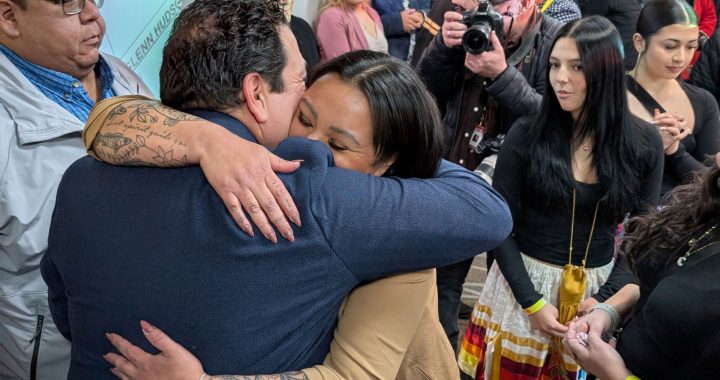Canada turned to U.S. for help on nuclear terror threats during Olympics: U.S. diplomatic cables
Canadian authorities lacked the ability to deal with dirty bombs and “improvised nuclear devices” during the 2010 Vancouver Olympic Games and turned to the U.S. to deal with the threat, according to “secret” U.S. diplomatic cables containing a Canadian shopping list to the U.S. military.
By Jorge Barrera
APTN National News
OTTAWA-Canadian authorities lacked the ability to deal with dirty bombs and “improvised nuclear devices” during the 2010 Vancouver Olympic Games and turned to the U.S. to help with the potential threat, according to “secret” U.S. diplomatic cables containing a Canadian shopping list to the U.S. military.
The U.S. embassy in Ottawa relayed at least two requests from Canada for possible “military to military assistance” to bolster security at the Games, according to the cables provided to APTN National News by whistle-blower website WikiLeaks.
The previously unreleased cables include the text of the diplomatic notes from Canada’s Foreign Affairs department outlining the requests.
The Canadian military has previously publicly acknowledged that U.S. military provided assistance for security at the games, but the details were never released for security reasons.
The Olympic Games proved controversial for many First Nations people, and groups protested all along the Olympic torch route. Plans to protest the games by First Nations and anti-poverty groups drew a lot of public attention from authorities and the media.
Behind the scenes, however, Canadian authorities were concerned about the use of a dirty bomb, also known as a “radiological dispersion device,” or nuclear devices constructed in Canada or brought in by terrorists.
In a diplomatic note from Foreign Affairs and sent by the U.S. embassy in Ottawa to the White House, among other U.S. government agencies, Canada asked the U.S. military to share its capabilities in the event this horrific scenario occurred.
“Although unlikely, Canada could potentially face the threat of an improvised or military nuclear device being constructed, or imported to, its national territory. Canada does not currently possess the capability for the rendering safe of a nuclear device,” according to “Annex C” of the diplomatic note contained in one of the embassy cables. “Canada therefore requests that, if required, U.S. capabilities and technical assistance for ‘render safe’ operations and transportation of an improvised nuclear device and/or a radiological dispersion device be made available to Canada.”
The Canadian government also requested capabilities to test biological, radiological or nuclear contaminated areas along with high altitude “radiological sensing capabilities,” one of the cables said.
Canada also requested U.S. military capabilities to extract victims of a radiological or biological attack and a hospital to deal treat the “non-contaminated and contaminated” victims and provide aircraft and helicopter capabilities to transport soldiers, equipment and a vehicle in the event of an emergency.
The cables were sent Jan. 7 and June 4, 2009, and requested a quick response from the U.S.
The U.S. had not responded officially to the January request by June 4, one of the cables note, quoting Shelley Whiting, Foreign Affairs Director for Defence and Security Relations.
“Whiting also requested an update on Canada’s first Olympics-related dip note, which Embassy conveyed to State for ExecSec transmittal to DOD for action in January, but which has not yet elicited an official response, despite Canada’s request at that time for 30-day turn-around (sic)” the June 4 cable noted, which also requested a response within 30 days.
The cables noted that U.S. military assets in Canada would be put under Canadian military command and U.S. military personnel would be put under RCMP protection.
Canada also asked the U.S. to provide 3D and high resolution surveillance imagery of Vancouver and the surrounding area to augment Canadian military intelligence.
Under the request, the U.S. military would have a presence in British Columbia linked to the Canadian military`s Joint Task Force Games before the Games began and receive intelligence on scenarios that could involve U.S. military assistance.
“The Canadian Forces would provide situational awareness to this element regarding developing situations that could involve a request for U.S. military assistance,” said one of the cables. “This element would remain in place during the 2010 Games and potentially remain until consequence management operations are complete.”
Steven Staples, of the Rideau Institute think-tank, said it was surprising the Canadian military needed to as the U.S. for this level of help on an event of the Olympic Games’ scale.
“It shows that the government’s priorities have been on places like Afghanistan instead of focusing on safety right here at home,” said Staples, who reviewed the cables.
Public Safety published a strategy on its website to deal with “chemical, biological, radiological and nuclear” threats.
“Continuing terrorist attacks around the world demonstrate that no country is immune from the threat of terrorism and there is ongoing concern over the threat of chemical, biological, radiological and nuclear (CBRN) terrorism,” according to the department’s website. “The Government of Canada has acted decisively to address the CBRN issue”
Staples said it appears the government’s strategy was still nothing more than paper by the time the Games rolled around.
“This was a priority of Public Safety years ago. They have documents…showing that they are preparing for a threat like this and who is responsible. Clearly it was a false sense of security,” said Staples. “When it really came down on something potentially real, they had to rush out and ask the Americans for help.”
Public Safety Canada did not immediately respond to a request for comment.
The Cables










